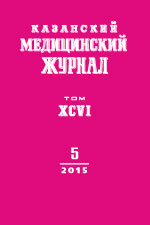Влияние эритропоэтина на содержание продуктов перекисного окисления липидов в лимфоцитах при экспериментальной термической травме
- Авторы: Осиков М.В.1, Симонян Е.В.1, Саедгалина О.Т.1
-
Учреждения:
- Южно-Уральский государственный медицинский университет
- Выпуск: Том 96, № 5 (2015)
- Страницы: 849-853
- Раздел: Экспериментальная медицина
- Статья получена: 28.03.2016
- Статья опубликована: 15.10.2015
- URL: https://kazanmedjournal.ru/kazanmedj/article/view/2041
- DOI: https://doi.org/10.17750/KMJ2015-849
- ID: 2041
Цитировать
Полный текст
Аннотация
Цель. Исследовать влияние различных концентраций эритропоэтина на содержание продуктов перекисного окисления липидов в лимфоцитах, выделенных из крови крыс с термической травмой.
Методы. Исследование выполнено на 22 белых нелинейных крысах-самцах. Термическую травму IIIА степени площадью 4% моделировали путём погружения в воду с температурой 98-99 °C. Через 24 ч из крови крыс выделяли лимфоциты и спектрофотометрически определяли содержание в них первичных (диеновых конъюгатов), вторичных (кетодиенов и сопряжённых триенов) и конечных продуктов (оснований Шиффа) перекисного окисления липидов. Эритропоэтин добавляли к лимфоцитам в концентрациях 0,01; 0,1 и 1 МЕ/мл.
Результаты. Установлено, что через 24 ч после термической травмы происходит накопление первичных, вторичных и конечных продуктов перекисного окисления липидов в изопропанольной фракции липидного экстракта лимфоцитов периферической крови. Добавление к лимфоцитам, выделенным из периферической крови крыс с термической травмой, эритропоэтина приводило к неоднозначным изменениям содержания продуктов перекисного окисления липидов: увеличению в гептановой фракции, снижению - в изопропанольной фракции липидного экстракта лимфоцитов. В гептановой фракции эритропоэтин увеличивал содержание первичных (в концентрациях 0,01; 0,1 и 1 МЕ/мл), конечных (при использовании концентрации 0,1 МЕ/мл) и вторичных (в концентрации 1 МЕ/мл) продуктов перекисного окисления липидов. В изопропанольной фракции эритропоэтин снижал содержание первичных (в концентрациях 0,01; 0,1 и 1 МЕ/мл), конечных (в концентрациях 0,01 и 0,1 МЕ/мл) и вторичных (в концентрациях 0,01 и 1 МЕ/мл) продуктов перекисного окисления липидов.
Вывод. Установлено, что при термической травме происходит накопление продуктов перекисного окисления липидов в изопропанольной фракции липидного экстракта лимфоцитов, выделенных из периферической крови крыс с термической травмой; применение эритропоэтина в концентрациях 0,01; 0,1 и 1 МЕ/мл приводит к увеличению содержания продуктов перекисного окисления липидов в гептановой фракции, снижению - в изопропанольной фракции липидного экстракта лимфоцитов.
Ключевые слова
Об авторах
Михаил Владимирович Осиков
Южно-Уральский государственный медицинский университет
Автор, ответственный за переписку.
Email: osaedgalina@mail.ru
Елена Владимировна Симонян
Южно-Уральский государственный медицинский университет
Email: osaedgalina@mail.ru
Оксана Тагировна Саедгалина
Южно-Уральский государственный медицинский университет
Email: osaedgalina@mail.ru
Список литературы
- Волчегорский И.А., Долгушин И.И., Колесников О.Л. и др. Экспериментальное моделирование и лабораторная оценка адаптивных реакций организма. - Челябинск: Изд-во ЧелГПУ, 2000. - 167 с.
- Дубинина Е.Е. Продукты метаболизма кислорода в функциональной активности клеток (жизнь и смерть, созидание и разрушение): физиологические и клинико-биохимические процессы. - СПб.: Медицинская пресса, 2006. - 400 с.
- Осиков М.В., Ахматов К.В., Федосов А.А. К вопросу о механизме влияния эритропоэтина на аффективный статус у больных хронической почечной недостаточностью, находящихся на гемодиализе // Фундамент. исслед. - 2012. - №7-1. - С. 140-145.
- Осиков М.В., Григорьев Т.А., Федосов А.А. и др. Эритропоэтин как регулятор экспрессии тромбоцитарных гликопротеинов // Соврем. пробл. науки и образования. - 2013. - №1. - URL: www.science-education.ru/107-7731 (дата обращения: 09.12.2014).
- Осиков М.В., Григорьев Т.А. Влияние эритропоэтина на активность систем плазменного протеолиза при экспериментальной почечной недостаточности // Бюлл. эксперим. биол. и мед. - 2012. - Т. 153, №1. - С. 27-30.
- Bohr S., Patel S.J., Shen K. Alternative erythropoietin-mediated signaling prevents secondary microvascular thrombosis and inflammation within cutaneous burns // Proc. Nat. Acad. Sci. - 2013. - Vol. 110, N 9. - P. 3513-3518. http://dx.doi.org/10.1073/pnas.1214099110
- Dang J., Jia R., Tu Y. Erythropoietin prevents reactive oxygen species generation and renal tubular cell apoptosis at high glucose level // Biomed. Pharmacotherap. - 2010. - Vol. 64, N 10. - P. 681-685. http://dx.doi.org/10.1016/j.biopha.2010.06.011
- Katavetin P., Tungsanga K., Eiam-Ong S. Antioxidative effects of erythropoietin // Kidney Int. Suppl. - 2007. - Vol. 107. - P. 10-15. http://dx.doi.org/10.1038/sj.ki.5002482
- Kim Y.J., Jung Y.W. Systemic injection of recombinant human erythropoietin after focal cerebral ischemia enhances oligodendroglial and endothelial progenitor cells in rat brain // Anat. Cell. Biol. - 2010. - Vol. 43, N 2. - P. 140-149. http://dx.doi.org/10.5115/acb.2010.43.2.140
- Meyer F.R.L., Steinborn R., Grausgruber H. at al. Expression of platelet-derived growth factor BB, erythropoietin and erythropoietin receptor in canine and feline osteosarcoma // Veterinary J. - 2015. - Vol. 204, N 3. - P. 233-240. http://dx.doi.org/10.1016/j.tvjl.2015.06.003
- Parihar A., Parihar M.S., Milner S. Oxidative stress and anti-oxidative mobilization in burn injury // Burns. - 2008. - Vol. 34, N 1. - P. 6-17. http://dx.doi.org/10.1016/j.burns.2007.04.009
- Penn J.W., Grobbelaar A.O., Rolfe K.J. The role of the TGF-β family in wound healing, burns and scarring: a review // Intern. J. Burns Traum. - 2012. - Vol. 2, N 1. - P. 18-28.
- Ravat F., Payre J., Peslages P. at al. La brûlure: une pathologie inflammatoire // Pathol. Biol. - 2011. - Vol. 59, N 3. - P. 63-72. http://dx.doi.org/10.1016/j.patbio.2009.12.001
- Shalom A., Kramer E., Westreich M. Protective effect of human recombinant copper-zinc superoxide dismutase on zone of stasis survival in burns in rats // Ann. Plastic Surg. - 2011. - Vol. 66, N 6. - P. 607-609. http://dx.doi.org/10.1097/SAP.0b013e3181fc04e1
- Zhang J., Zhu Y., Zhou D. Recombinant human erythropoietin (rhEPO) alleviates early brain injury following subarachnoid hemorrhage in rats: possible involvement of Nrf2-ARE pathway // Cytokine. - 2010. - Vol. 52, N 3. - P. 252-257. http://dx.doi.org/10.1016/j.cyto.2010.08.011
Дополнительные файлы







